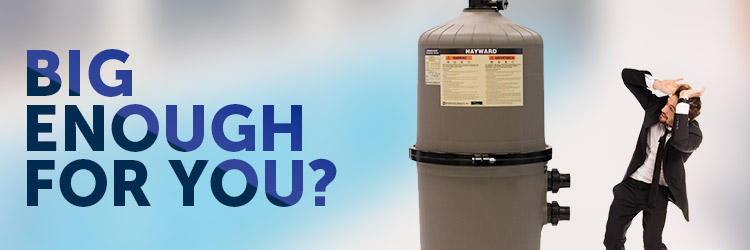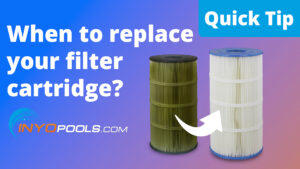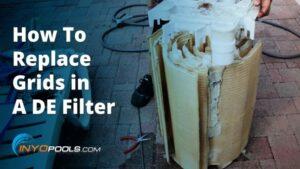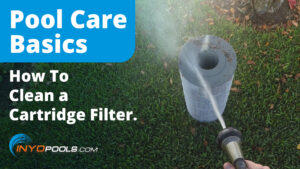The simple answer that most pool pros will give the perplexed pool owner is a straight “no.” That answer usually allays their worries due to its simplicity but we here at Inyo like to dig a little deeper. So here we are to give the reasoning behind the “Go Big or Go Home” logic of pool filters.
Flow Rates
Take a look at your current filter’s tag (if it is still readable, of course) and you will note the jumble of numbers and ratings that adorn it. The list is likely to include  maximum working pressure, filtration rate, filter media requirement and even clearance. All this information is important for the proper operation and installation of the filter. Without the aforementioned ratings, we would not know when to clean or replace the filter media. Also, knowing proper clearance helps us avoid plopping the filter in an area that makes it totally inaccessible to be serviced. All that info is need to know!
maximum working pressure, filtration rate, filter media requirement and even clearance. All this information is important for the proper operation and installation of the filter. Without the aforementioned ratings, we would not know when to clean or replace the filter media. Also, knowing proper clearance helps us avoid plopping the filter in an area that makes it totally inaccessible to be serviced. All that info is need to know!
Amongst the rabble of numbers, do you see a minimum flow rate? No. The reason being is that there is no true “minimum flow rate” of a filter. The tank may take longer to fill up if we have a ½ HP pump on a 800 pound commercial sand tank but the filter will still scrub the water to the same standard.
Advantages to Over-sizing
Maintenance
The main advantage to over-sizing a filter is the reduction of cleaning throughout the pool season. With the larger filter there is more media in which the dirt can disperse, allowing water to flow freely. The larger the cartridge, the more dirt it can trap. The more dirt it traps, the longer we can go in between backwashes or cartridge hose-downs. And what does that mean for the sometimes lazy homeowner, like myself? FREE TIME!
Even the most fervent of pool geeks does not enjoy backwashing a sand filter on a hot Saturday in July. Oversizing is a no brainer for the person who is constantly monitoring their pressure gauge as it will lessen the likelihood of seeing DEFCON 1 type pressure readings. By upping your filter media, you increase the area in which the dirt and debris is held, allowing the filter to maintain optimal water pressure for longer.
Motor Longevity
Your motor’s one and only job is to pull water from your pool basin and send it through the filtering system, it is a simple but a difficult job. This job is made harder when the motor must fight built-up back pressure from an overwhelmed filter causing issues for both pieces of equipment.
For example let us say our pump has an output of 100 gallons per minute (GPM) but our pool filter can realistically handle only 50 GPM; the overflow of 50 GPM is stressing your system in two ways, overworking the filter which will likely lead to a premature failure, and secondly, the motor is overworking to as it attempts to push against the growing back pressure. The resulting struggle between the filter’s filtering capacity and the pump’s flow rate will eventually lead to a costly repair bill after one or both breaks.
If we alter the flow rates and make the filter 125 GPM and the pump 100 GPM, the filter can easily handle the pump’s flow rate. Also, the extra buffer in the filter’s flow capacity compensates for dirty filter media which will lessen the actual filter rate between cleanings. With a properly sized filter the pool is quickly and effortlessly cycled through the system while never testing the limits of your equipment. This makes for a happy and long lasting filtering system.
Changing Filter Media
The increase in filter size also means the sand, grids or cartridges are under less stress per square foot. A reduction in workload both from the flow rate and dirt increases its lifespan. The adage “less stress, longer life” applies to filter media and pool owner alike. The rigors of high flow rate, high dirt load and repetitiveness of cleaning can put a filter through the wringer.
The Dangers of Under-sizing
What happens when you overfill a water balloon? It bursts. Now imagine a water balloon large enough to hold 300 pounds of sand doing the same thing. Indeed, what a mess. That particular scenario is unlikely to happen to a filter’s tank but pipe bursts or other plumbing malfunctions may occur. These issues arise from back pressure created by a filter that cannot keep up with the pump.
Also, the need to clean your filter becomes a constant. When a filter gets dirty its flow rate capacity lessens, creating a rise in back pressure. This rise is seen in the pressure gauge and is the first sign that cleaning is necessary. If cleaning does not fix the issue, it may be time to replace your sand or cartridge.















Leave a Reply